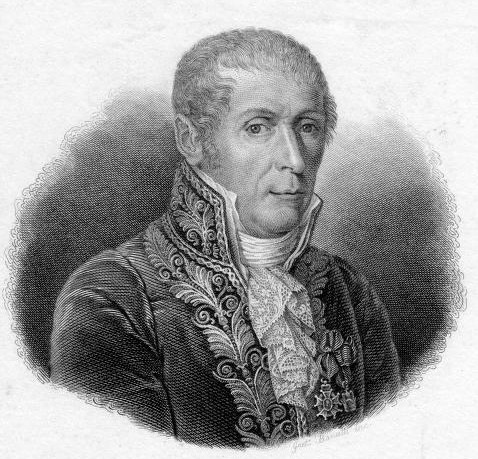<Back to Index>
- Physicist Count Alessandro Giuseppe Antonio Anastasio Volta, 1745
- Painter Thomas Girtin, 1775
- Queen of England Mary I, 1516

Count Alessandro Giuseppe Antonio Anastasio Volta (February 18, 1745 – March 5, 1827) was an Italian physicist known especially for the development of the first electric cell in 1800.
Volta was born in Como, Italy and was taught in the public schools there. In 1774 he became a professor of physics at the Royal School in Como. A year later, he improved and popularized the electrophorus, a device that produces a static electric charge. His promotion of it was so extensive that he is often credited with its invention, even though a machine operating in the same principle was described in 1762 by Swedish professor Johan Wilcke.
In 1776-77 Volta studied the chemistry of gases, he discovered methane by collecting the gas from marshes. He devised experiments such as the ignition of methane by an electric spark in a closed vessel. Volta also studied what we now call electrical capacitance, developing separate means to study both electrical potential (V) and charge (Q), and discovering that for a given object they are proportional. This may be called Volta's Law of capacitance, and likely for this work the unit of electrical potential has been named the volt.
In 1779 he became professor of experimental physics at the University of Pavia,
a chair he occupied for almost 25 years. In 1794, Volta married Teresa
Peregrini, with whom he raised three sons, Giovanni, Flaminio and
Zanino. Volta began to study, around 1791, the "animal electricity" noted by Luigi Galvani when
two different metals were connected in series with the frog's leg and
to one another. Volta realized that the frog's leg served as both a
conductor of electricity (we would now call it an electrolyte)
and as a detector of electricity. He replaced the frog's leg by
brine-soaked paper, and detected the flow of electricity by other means
familiar to him from his previous studies. In this way he discovered the electrochemical series, and the law that the electromotive force (emf) of a galvanic cell, consisting of a pair of metal electrodes separated
by electrolyte, is the difference between their two electrode
potentials. (Thus, two identical electrodes and a common electrolyte
give zero net emf.) This may be called Volta's Law of the
electrochemical series. In 1800, as the result of a professional disagreement over the galvanic response advocated by Galvani, he invented the voltaic pile, an early electric battery, which produced a steady electric current. Volta had determined that the most effective pair of dissimilar metals to produce electricity was zinc and silver. Initially he experimented with individual cells in series, each cell being a wine goblet filled with brine into
which the two dissimilar electrodes were dipped. The electric pile
replaced the goblets with cardboard soaked in brine. In announcing his discovery of the pile, Volta paid tribute to the influences of William Nicholson, Tiberius Cavallo and Abraham Bennet. An additional invention pioneered by Volta, was the remotely operated pistol. He made use of a Leyden jar to send an electric current from Como to Milan (~50
km or ~30 miles), which in turn, set off the pistol. The current was
sent along a wire that was insulated from the ground by wooden boards.
This invention was a significant forerunner of the idea of the
telegraph which also makes use of a current to communicate. In honor of his work, Volta was made a count by Napoleon in 1810. Volta retired in 1819 in his estate in Camnago, a frazione of Como now called Camnago Volta after him, where he died on March 5, 1827. He is buried in Camnago Volta. Volta's legacy
is celebrated by a Temple on the shore of Lake Como in the centre of
the town. A museum in Como, the Voltian Temple, has been built in his
honor and exhibits some of the original equipment he used to conduct
experiments. Near Lake Como stands the Villa Olmo,
which houses the Voltian Foundation, an organization which promotes
scientific activities. Volta carried out his experimental studies and
made his first inventions in Como.